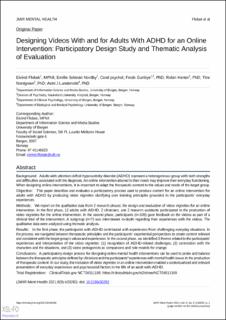| dc.contributor.author | Flobak, Eivind | |
| dc.contributor.author | Nordby, Emilie Sektnan | |
| dc.contributor.author | Guribye, Frode | |
| dc.contributor.author | Kenter, Robin Maria Francisca | |
| dc.contributor.author | Nordgreen, Tine | |
| dc.contributor.author | Lundervold, Astri J. | |
| dc.date.accessioned | 2022-04-01T13:28:34Z | |
| dc.date.available | 2022-04-01T13:28:34Z | |
| dc.date.created | 2021-10-14T16:04:52Z | |
| dc.date.issued | 2021 | |
| dc.identifier.issn | 2368-7959 | |
| dc.identifier.uri | https://hdl.handle.net/11250/2989341 | |
| dc.description.abstract | Background: Adults with attention deficit hyperactivity disorder (ADHD) represent a heterogeneous group with both strengths and difficulties associated with the diagnosis. An online intervention attuned to their needs may improve their everyday functioning. When designing online interventions, it is important to adapt the therapeutic content to the values and needs of the target group.
Objective: This paper describes and evaluates a participatory process used to produce content for an online intervention for adults with ADHD by producing video vignettes clarifying core training principles grounded in the participants' everyday experiences.
Methods: We report on the qualitative data from 2 research phases: the design and evaluation of video vignettes for an online intervention. In the first phase, 12 adults with ADHD, 2 clinicians, and 2 research assistants participated in the production of video vignettes for the online intervention. In the second phase, participants (n=109) gave feedback on the videos as part of a clinical trial of the intervention. A subgroup (n=7) was interviewed in-depth regarding their experiences with the videos. The qualitative data were analyzed using thematic analysis.
Results: In the first phase, the participants with ADHD contributed with experiences from challenging everyday situations. In the process, we navigated between therapeutic principles and the participants' experiential perspectives to create content relevant and consistent with the target group's values and experiences. In the second phase, we identified 3 themes related to the participants' experiences and interpretation of the video vignettes: (1) recognition of ADHD-related challenges, (2) connection with the characters and the situations, and (3) video protagonists as companions and role models for change.
Conclusions: A participatory design process for designing online mental health interventions can be used to probe and balance between the therapeutic principles defined by clinicians and the participants’ experiences with mental health issues in the production of therapeutic content. In our study, the inclusion of video vignettes in an online intervention enabled a contextualized and relevant presentation of everyday experiences and psychosocial factors in the life of an adult with ADHD. | en_US |
| dc.language.iso | eng | en_US |
| dc.publisher | JMIR Publications | en_US |
| dc.rights | Navngivelse 4.0 Internasjonal | * |
| dc.rights.uri | http://creativecommons.org/licenses/by/4.0/deed.no | * |
| dc.title | Designing Videos with and for Adults with ADHD for an Online Intervention: Participatory Design Study and Thematic Analysis of Evaluation | en_US |
| dc.type | Journal article | en_US |
| dc.type | Peer reviewed | en_US |
| dc.description.version | publishedVersion | en_US |
| dc.rights.holder | Copyright 2021 the authors | en_US |
| dc.source.articlenumber | e30292 | en_US |
| cristin.ispublished | true | |
| cristin.fulltext | original | |
| cristin.qualitycode | 1 | |
| dc.identifier.doi | 10.2196/30292 | |
| dc.identifier.cristin | 1946050 | |
| dc.source.journal | JMIR Mental health | en_US |
| dc.relation.project | Norges forskningsråd: 259293 | en_US |
| dc.identifier.citation | JMIR Mental health. 2021, 8 (9), e30292. | en_US |
| dc.source.volume | 8 | en_US |
| dc.source.issue | 9 | en_US |

